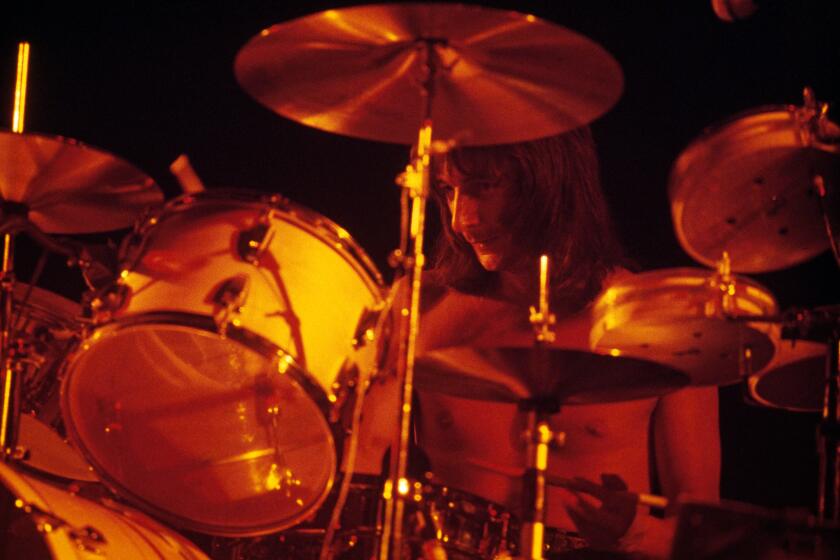PICTURE THIS: CDs WITH VIDEO, BY CHRISTMAS ’87
Two ‘80s phenomena, the compact disc and the music video, are getting ready to join up.
Despite sporting everything from scantily clad women to some of the biggest superstars in show business, music videos have never been as big in the home video market as they have on MTV and other television outlets. But the music industry will soon have a new way of marketing them.
It’s called CD-V.
CD-V stands for compact disc-video. According to trade publications Daily Variety and Video Week, compact disc co-developers Sony and Philips have ended their squabbles over the introduction of a disc that, in addition to holding up to 20 minutes of audio, will also contain up to six minutes of video .
Prototypes of the new CD-Vs were demonstrated Monday at the National Assn. of Recording Merchandisers convention in Miami Beach by PolyGram Records, a Philips subsidiary.
The discs work on the same digital-coding/laser-beam-pickup method that present compact discs use. They’ll be the same size as CDs too; in fact, they’ll apparently look just like them except they’ll be colored gold rather than silver. You’ll even be able to play the audio portion of the 4.8-inch CD-Vs on your current compact-disc player.
But not the video part.
New combination audio/video machines will be introduced that will play both sections of the (for the most part) pop-music 4.8-inch CD-Vs. They’ll probably also handle 12-inch laser discs (usually containing movies) and another new CD-V size, an 8-inch disc primarily to be used for classical music. The 4.8-inch discs contain only about 26 minutes of information, compared to a normal CD’s 73, because the disc must spin faster for video.
Now that Sony and Philips have patched up their differences, industry insiders are expecting models to be demonstrated at the Summer Consumer Electronics Show in Chicago in June, with players and discs expected to be ready for Christmas season sales.
(The two firms may also try to jointly develop a 3-inch CD single, to join the cassette single, which is making its debut with A&M;’s new Bryan Adams single “Heat of the Night.” These formats are expected to eventually take the place of vinyl singles.)
Just as compact discs look like the future of music (unless they’re upstaged by the introduction later this year of digital audio tape), CD-Vs seem like the future of music video--in sales terms, anyway. However, it remains to be seen whether music video can ever be marketed with great success.
In the last five years, every major video category has grown significantly in consumer acceptance--except for music tapes. According to Video Insider, video retailers have one-third fewer music videocassettes in inventory now than in 1985, and the tapes earned half the revenue that music cassettes earned that year. It remains to be seen whether music-clip combinations and other music-video applications will do better on CD-V.
There are also some other clouds of doubt over the CD-V horizon. While it looks like Sony and Philips will cooperate in the development and marketing of CD-V, as they fruitfully did with CD a few years ago, some agreement also may have to be hammered out with LaserVision patent owner Pioneer, which already makes its own combination players. Pioneer, in cooperation with Capitol Records, has even released a few 12-inch laser discs that contain a full album in audio plus two or three video clips.
If a pact is not worked out on common technical specifications, a format war similar to the VHS-vs.-Beta videotape competition may result.
Also, Philips and Sony must determine how the new CD-V software will be handled in cooperation with record companies. The video clips shown at Miami Beach were merely on loan. Pioneer already has limited agreements with some labels. PolyGram Records has already set up a CD Video division, to be managed by the head of its PolyGram Classics division, but other record companies may have more of a wait-and-see attitude.
Another possible problem for CD-V developers is the promised introduction of a Super-VHS system by JVC, which also is aiming for a late-1987 U.S. marketing date. If Super-VHS fulfills the company’s reports of an image as sharp or sharper than broadcast-quality (400-plus lines of horizontal resolution), its impact could affect not only the videotape field but spread into other areas, including CD-V and other video disc innovations--at least until recordable video discs are made practical.
Of course, there may be room for both Super-VHS and CD-V in our gadget-infatuated land. And just as soon as they catch on, digital videotape will probably be introduced. That means--stop me if you’ve heard this one before--another wave of new hardware and software will sweep away the “old” gear. This is one area where equipment is often outmoded before it even has a chance to break down.
More to Read
The biggest entertainment stories
Get our big stories about Hollywood, film, television, music, arts, culture and more right in your inbox as soon as they publish.
You may occasionally receive promotional content from the Los Angeles Times.






